



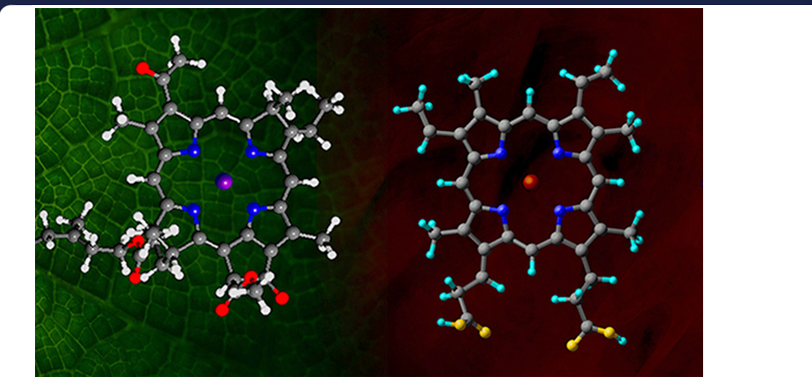
Resonant Transmutation of Magnesium in Chlorophyll
Solar Chlorophyll and the Subtle Radiance of Leaves
by Alex Putney for Human-Resonance.org
January 11, 2013 - Updated on April 25, 2013
The symbiotic respiration processes of cyanobacteria, algae, and plants with those of animals mitigate the perpetual rebalancing of gases enveloping our planet, in conjunction with the cleansing processes of atmospheric lightning. The essential exchange of gases in this delicate global respiration cycle of life primarily involves carbon dioxide, oxygen and nitrogen, which are processed within the bodies of both plants and animals using specialized molecules that bind gases with metals to produce resonant nuclear reaction cascades that are responsible for the subtle radiance of all living organisms.
The photosynthetic functions of chlorophyll have been well understood for decades as an essential metabolic process that converts solar photons into chemical energy that becomes stored as sugars in the vast variety of colorful and delicious fruits, vegetables, legumes, nuts, germs and grains we enjoy. However, the origin of the ultraweak luminosity of plants, and leaves in particular, and the role of these biophotons in the luminal field communications of all living organisms has only recently been identified.
The ripening of fruit is signaled by the subtle ultraviolet glow that is also known to be used by flowers for communication with the multitudes of insect species that spread pollen widely, just as seeds of the ripened fruit become dispersed by animals in their feeding and excrement. Biophoton cameras have been developed using photomultiplyer techniques to amplify and accurately visualize the biophoton field of living organisms in real-time. Leaves, like all living matter, store photons from sunlight for milliseconds during which time these photons form standing waves within DNA strands before being re-emitted as 'delayed luminescence'. After the extinction of re-emitted photons, the spontaneous ultraweak photon emission of leaves continues at a stable rate even in the absence of light.
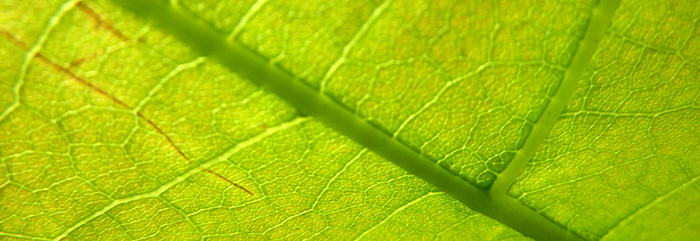
Previously identified temperature-dependent atomic transmutation reactions occurring in the many blood varieties of animals provide further insight into the nuclear origin of the ultraweak biophoton emission of green algae and plants. The green biochrome pigment chlorophyll binds magnesium and oxygen atoms, implicating a resonant atomic fusion reaction forming sulfur and phosphorus and releasing soft multi-photon radiation in the visible light range. Indeed, investigations of the variation of sulfur concentration in tree leaves has ruled out the environmental uptake of sulfur (Reimann, et al., 2003):
Leaves of up to eleven different plant species... have been collected from up to nine catchments... spread over a 1,500,000 km2 area in northern Europe and analysed for 'total' (digestion by 16M HNO3) sulphur concentrations... Willow leaves show by far the highest total S concentrations. They are, however, not related to pollution but were observed in the catchment nearest to the coast of the Barents Sea.
The measured S concentrations in the leaves do not correlate well either with 'available' or total S in the soils. Several different pathways must be considered for leaf uptake of S in all plants. The important role of S as a major plant nutrient and the consequently high background concentrations and variations prohibit the use of leaves as reliable indicators of SO2 pollution levels in air. It is not possible to establish general 'background' S concentrations in plant leaves for a very large area.

The systematic study of leaf catchments found no correlation between sulfur concentrations in leaves and environmental sources, as sulfur is converted within chlorophyll from magnesium, and is thereby linked to the uptake of available sources of magnesium and the exact set of conditions under which such reactions occur. Magnesium atoms split oxygen to form helium, hydrogen and sulfur atoms.
Resonant fusion reactions occurring in green chlorophyll molecules produce hydrogen, helium, sulfur and unstable sulfur (S31) atoms, with a half-life of 2.572 seconds, undergoing positron emission during ß+ decay to form stable phosphorus (P31) atoms. This vital cascade of temperature-dependent, resonant atomic recombinations taking place in leaves can be clearly expressed as:

Direct sunlight triggers resonant chain reactions releasing positrons and neutrinos that stimulate leaf turgor pressure by the gating of aquaporins, also enhanced by reactive oxygen species. Solar photons scattered within algae and plant leaf cells become stored as standing waves within the DNA molecules comprising chromatin --an exiplex laser array. While the photon-storing capacity of DNA has been known for decades, the three major properties of biophotons have only recently been described as gamma products of biological nuclear transmutations (Widom, et al., 2011).
The high degree of accuracy of the presently available atomic data allows for precision phonon resonance calculations that reveal the delicate fabric of atomic vibratory relationships enabling the astounding coherence of photon fields of living matter that have evaded all prior scientific inquiry.

The resonant conversion of magnesium into sulfur and phosphorus takes place within chlorophyll molecules at a rate that is determined by the seasonal temperature conditions of the environment, according to the specific thermal expansion and dimensional characteristics of the elements.
Phonon resonance determinations confirm this reaction occurs by frequency matching in the heat of daylight. Low energy fusion of magnesium atom pairs with oxygen atoms to form sulfur pairs occurs at the resonant frequency of unstable target isotope (S31) in its rest state -at 34,250,831 Hz. Magnesium starting isotope (Mg26) resonates at this exact phonon frequency during precision heating to 28.1°C:
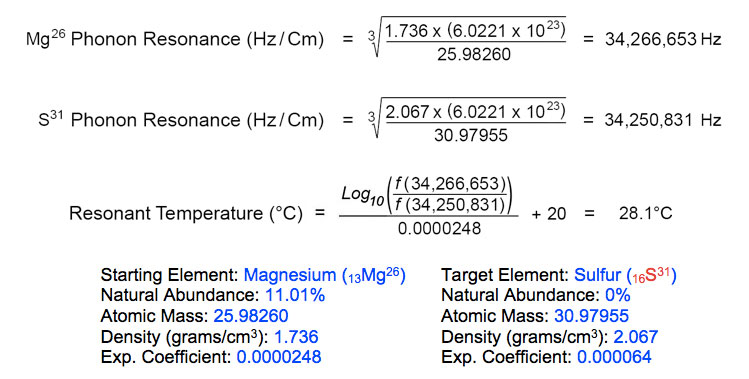
Green terrestrial and aquatic plants, algae and phytoplankton species that produce chlorophyll for photosynthesis are able to optimize the fusion of magnesium and oxygen atoms in direct sunlight, which brings the sunlit surfaces of leaves and the oceans to the required resonance at 28.1°C. The great abundance of atmospheric oxygen on Earth is produced by the great variety of green phytoplankton species of our oceans, which thrive wherever warm pelagic waters meet colder upwellings.

Comparison of sea surface chlorophyll concentrations with sea surface temperature variation reveals the specific oceanic conditions that stimulate massive plankton blooms observable from orbit high above. Large deep-water upwellings driven up the steep volcanic cones of Ecuador's Galapagos Islands convey nutrient-rich waters to sunlit pelagic zones where the photosynthesis of phytoplankton is maximized (above). The diurnal nuclear transmutation cascades of magnesium into sulfur and phosphorus that occur within chlorophyll require this exact temperature range at 28.1°C ( ± 2°C).
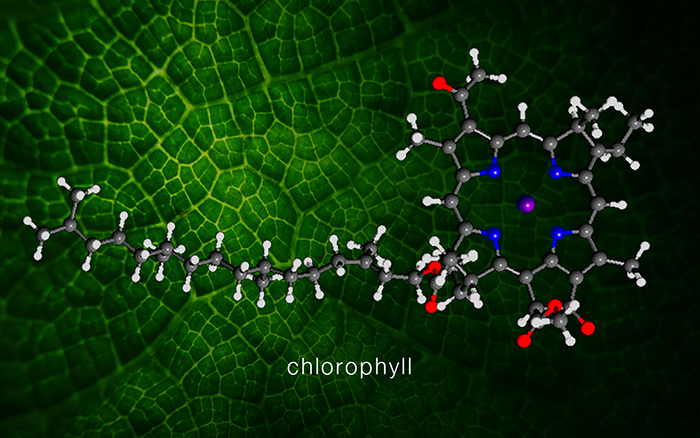
Chlorophyll's temperature-dependent nuclear transmutations are induced within an octagonal planar hydrocarbon ring consisting of 4 pentagonal pyrroles, each presenting a nitrogen atom toward the center of the ring as a potential binding site for magnesium ions (rendered above, with nitrogen atoms shown in blue and the central magnesium ion in purple). Called porphyrin in its simplest form, this ring structure is present in many organometallic molecules including biochrome and cytochrome pigments, vitamin B12 and the catalases, among many others. This multi-purpose ring molecule also binds an iron ion as ferroporphyrin, or heme, which combine in groups of four in the formation of hemoglobin, the oxygen-transporter found in the red blood cells of terrestrial and aquatic mammals, birds and fish.
The similarity of the chemical structures of chlorophyll and heme were first pointed out over 150 years ago (Verdel, 1855), and nutritional studies followed much later confirming the dietary benefits of chlorophyll in the synthesis of hemoglobin by animals (Saunders, 1926; Patek, 1936; Hughes & Latner, 1936). Deeply green-colored organisms contain the greatest concentrations of chlorophyll, showing the richest sources to be found in cyanobacteria such as spirulina, and the alga chlorella, as well as commonly known leafy plants such as seaweed, spinach, kale, Swiss chard, parsley, asparagus, peas, broccoli, brussel sprouts, green beans, romaine lettuce, leeks, etc...
Stimulation of hemoglobin production by porphyrin was also specifically identified (Hammel-Dupont & Bessman, 1970), while the present findings reveal temperature-dependent biophotonic functions of chlorophyll and hemoglobin pigments, as generated by the phonon resonance reactions of metals and absorbed gases within the living tissues of green plants and red-blooded animals, respectively:

The minute disparity in atomic mass between the starting elements and target elements involved in these paired resonant nuclear fusion reactions is emitted as photons in the visible spectral range that excite and coordinate the great variety of cellular metabolic processes perpetually working in concert.
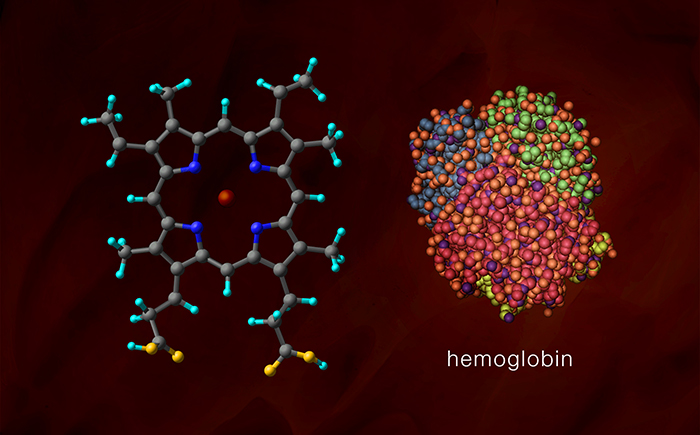
At the core of each myoglobin molecule and each of the four heme groups comprising hemoglobin sits a ferroporphyrin --an octagonal planar hydrocarbon ring with 4 central nitrogen atoms binding an iron ion (rendered above, with nitrogen atoms shown in blue and iron represented in red). The presence of helium in red blood provides strong evidence for conversion of individual iron atoms in hemoglobin molecules, suggesting a similar reaction involving emisson of helium byproducts in the case of nuclear reactions of magnesium and oxygen in chlorophyll molecules.
Notable shifts in the isotopic ratios of blood copper have been observed to accumulate over time, and this distinct rate of enhancement of heavier isotopes confirms their origin as nuclear fusion products. As with shifts in blood copper isotopes, heavier nuclear fusion products have been confirmed in tree leaves by the significant mean increase of ~1% in the sulfur isotope ratio (S34 : S32) (Menegário, et al., 1998). Such miniscule but unmistakable isotopic signatures of biological copper and sulfur attest to the secret inner light of life, and resonant vibratory relationships of all physical matter in the cosmos.
Looking beyond the structural and functional similarities of chlorophyll and hemoglobin molecules, the existence of a much deeper symbiotic relationship between green plants and red-blooded human beings reveals a profound spiritual lesson concerning biorhythmic resonance.
The life-giving influences of solar radiations upon the living organisms of our planet occurs through the bioelectric stimulation of these temperature-dependent atomic transmutation cascades that illuminate and coordinate the metabolic processes of all living cells. The coherence of biophoton field communications is enabled by the distinct qualities of light generated by resonant nuclear conversions that are calibrated by the phonon architecture of dimensional relationships among the elements.
Ancient Sanskrit knowledge preserved from Atlantean times, before the global destruction, identifies the resonant infrasound field of the planets as the Cosmic Om, which constantly strikes all living organisms to infuse them with the invisible energy of life. This advanced awareness of the cosmos was reawakened in the West through the synthesis of the concept of bioelectrification with the modern scientific rediscovery and description of resonant infrasound standing waves by Nikola Tesla in 1899.

Sanskrit teachings on the relationship of human beings with the cosmic emanations through living trees is preserved in ancient Aramaic and Hebrew texts. The Essene Gospel of Peace, Book 4, translated by E.B. Szekely, clearly identifies the divine influences of infrasound standing waves as The Holy Streams. The healer now known as 'Jesus of Nazareth' taught that human beings access the Holy Stream of Life through 'unification' by heartbeat synchronization with his Brother Tree:
Now in the hour before the rising of the sun, just before the angels of the Earthly Mother breathe life into the still sleeping earth, then do you enter into the Holy Stream of Life. It is your Brother Tree who holds the mystery of this Holy Stream, and it is your Brother Tree that you will embrace in your thought, even as by clay you embrace him in greeting when you walk along the lake shore. And you shall be one with the tree, for in the beginning of the times so did we all share in the Holy Stream of Life that gave birth to all creation. And as you embrace your Brother Tree, the power of the Holy Stream of Life will fill your whole body, and you will tremble before its might. Then breathe deeply of the angel of air, and say the word "Life" with the outgiving of breath. Then you will become in truth the Tree of Life which sinks its roots deep into the Holy Stream of Life from an eternal source. And as the angel of sun warms the earth, and all the creatures of land and water and air rejoice in the new day, so will your body and spirit rejoice in the Holy Stream of Life that flows to you through your Brother Tree.
This sacred knowledge of the radiant cosmic symbiosis of the human being and the tree has also been preserved among the Vedruss adepts of the Siberian taiga, who live in mastery of Sanskrit Ayurveda. Vedruss Elder Anastasia demonstrates that the energy fields of human beings can become amplified through the simple DNA imprinting of seeds, whereby imprinted groves of trees act as a resonant broadband antenna array that stores and transduces all localized infrasound into resonance with the heartbeat rhythms of that DNA lineage [--V Megre (2001) 'Anastasia' Ringing Cedars Press, pp.6-8]:
"God created the cedar to store cosmic energy... When someone is in a state of love they emit a radiant energy. It takes but a split second for it to reflect off the planets floating overhead and come back to Earth to give life to everything that breathes."
"The Sun is one of those planets, and it reflects but a tiny fraction of such radiance. Only bright rays can travel into Space from Man on the Earth. And only beneficial rays can be reflected from Space back to Earth."
"Under the influence of malicious feelings Man can emit only dark rays. These dark rays cannot rise but must fall into the depths of the Earth. Bouncing off its core, they return to the surface in the form of volcanic eruptions, earthquakes, wars, etc. The culminating achievement of these dark rays is their direct effect on the Man originating them, invariably exacerbating the man's own malicious feelings."

"Cedars live to be five hundred and fifty years old. Day and night their millions of needles catch and store the whole spectrum of bright energy.* During the period of the cedars' life all the celestial bodies which reflect this bright energy pass above them."
"Even in one tiny piece of cedar there is more energy beneficial to Man than in all the man-made energy installations taken together. Cedars receive the energy emanating from Man through Space, store it up and at the right moment give it back. They give it back when there is not enough of it in Space --and, consequently, in man-- or in everything living and growing on the Earth."
"Occasionally, though very rarely, one discovers cedars that have been storing up energy but not giving back what they have stored. After five hundred years of their life they start to ring. This is how they talk to us, through their quiet ringing sound --this is how they signal people to take them and cut them down to make use of their stored-up energy on the Earth. This is what the cedars are asking with their ringing sound. They keep on asking for three whole years. If they don't have contact with living human beings, then in three years, deprived of the opportunity to give back what they have received and stored through the Cosmos, they loose their ability to give it back directly to Man. Then they will start burning up the energy internally. This torturous process of burning and dying lasts twenty-seven years."
"Not long ago we discovered a cedar like this. We determined that it had been ringing for two years already. It was ringing very, very softly. Perhaps it was trying to draw out its request over a longer period of time, but still, it has only one year left. It must be sawed up and given away to people."
*Footnote - Trees indeed capture a wide range of radiation beyond the visible light. Man-made antennas are but an imitation of branching pattern in trees. Both the structure of trees and the materials composing them betray natural wave receptors. Tree sap is a great conductor of electricity (this is why a tree hit by lightning virtually explodes), and static electricity was first received from amber - a fossil resin from conifer trees.
Copyright 2013-2015 Alexander Putney